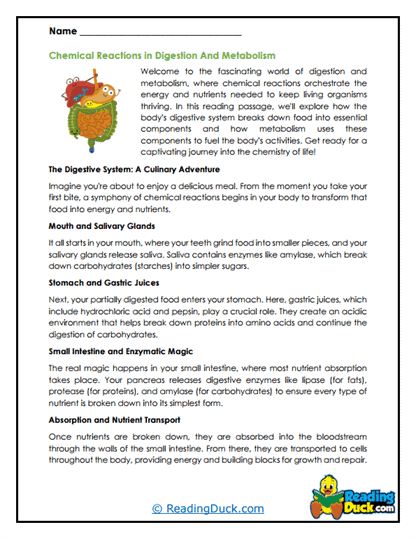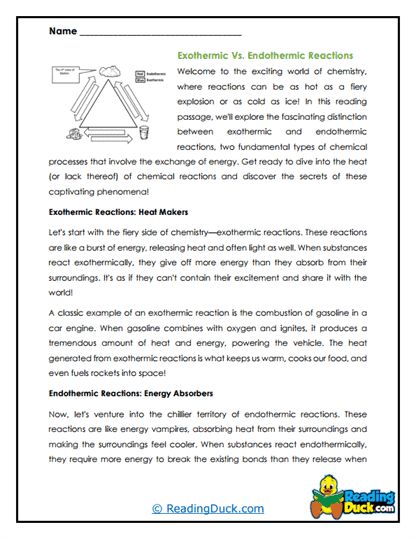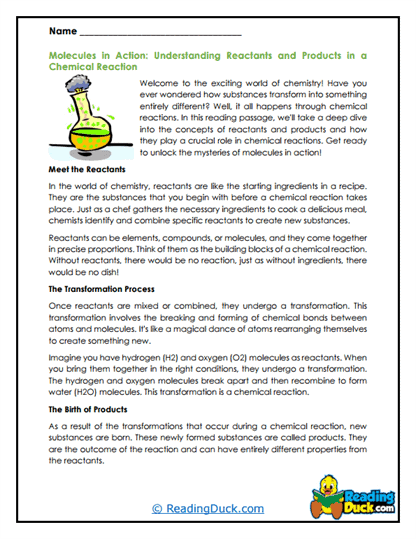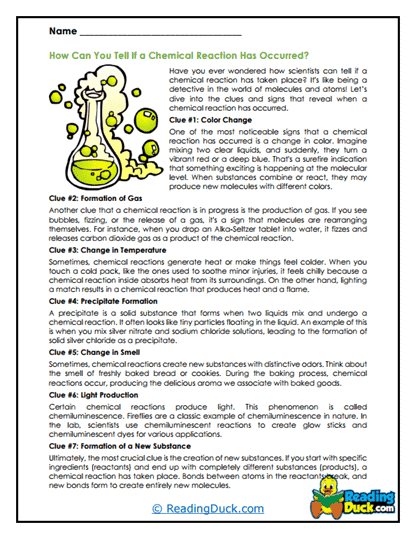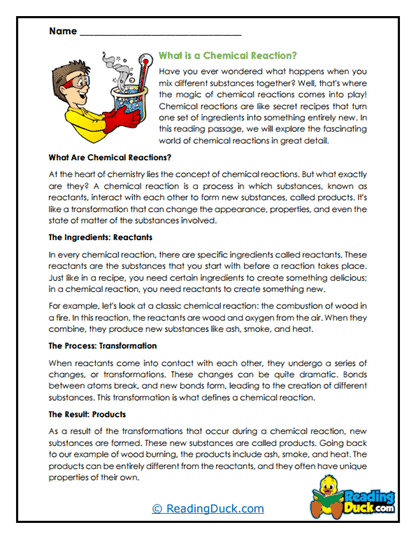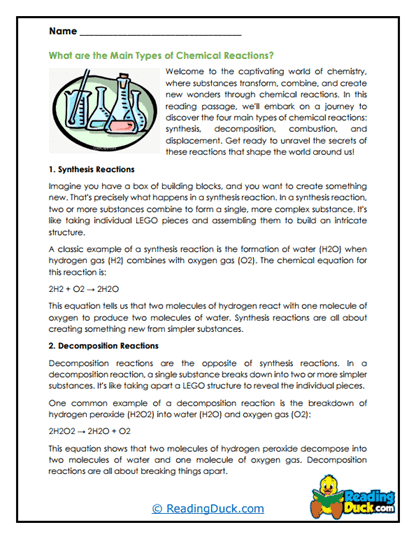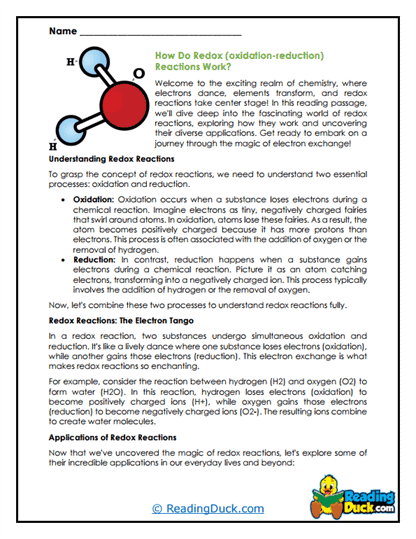Chemical Reactions Worksheets
About Our Chemical Reactions Worksheets
Our collection of Chemical Reactions worksheets is designed to provide students with a comprehensive understanding of the fundamental processes that drive chemical changes in matter. As a subtopic of Chemistry, chemical reactions are essential for grasping how substances interact, transform, and produce new materials. These worksheets are crafted to engage students and deepen their comprehension of chemical reactions, ensuring they build a strong foundation in this critical area of science.
This collection contains numerous worksheet sets, each focused on different aspects of chemical reactions:
- Multiple Choice Questions: These questions test students' understanding of key concepts such as the types of chemical reactions, the law of conservation of mass, and the role of reactants and products. They encourage students to recall and apply their knowledge in various scenarios.
- Short Answer Questions: These prompts require students to explain concepts in their own words, such as describing the difference between exothermic and endothermic reactions, balancing chemical equations, or identifying reaction types.
- Open-Ended Questions: These questions challenge students to think critically and express their insights on topics like the importance of chemical reactions in daily life, the environmental impact of certain reactions, or comparing different reaction rates.
These worksheets not only reinforce students' understanding of chemical reactions but also foster critical thinking and personal engagement with the material. An answer key is provided for every question sheet, facilitating guided learning and self-assessment. All of the worksheets are available as PDF files, which can be easily viewed electronically, downloaded, and printed out.
Understanding the Basics of Chemical Reactions
1. Types of Chemical Reactions:
- Synthesis Reactions:
- Definition and Examples: In a synthesis reaction, two or more simple substances combine to form a more complex product. For instance, when hydrogen gas reacts with oxygen gas, it forms water (2H₂ + O₂ → 2H₂O).
- Application: This type of reaction is crucial in industries that produce compounds like ammonia and sulfuric acid, which are foundational to manufacturing and agriculture.
- Decomposition Reactions:
- Definition and Examples: Decomposition reactions involve a single compound breaking down into two or more simpler substances. For example, the electrolysis of water into hydrogen and oxygen gases (2H₂O → 2H₂ + O₂) is a classic decomposition reaction.
- Application: Decomposition reactions are essential in recycling processes, where materials are broken down to recover valuable components.
- Single Replacement Reactions:
- Definition and Examples: In a single replacement reaction, one element replaces another in a compound, forming a new compound and a separate element. An example is the reaction between zinc and hydrochloric acid, which produces zinc chloride and hydrogen gas (Zn + 2HCl → ZnCl₂ + H₂).
- Application: These reactions are used in metal extraction and refining, where more reactive metals displace less reactive metals from their compounds.
- Double Replacement Reactions:
- Definition and Examples: Double replacement reactions occur when two compounds exchange ions to form two new compounds. A common example is the reaction between silver nitrate and sodium chloride, which produces silver chloride and sodium nitrate (AgNO₃ + NaCl → AgCl + NaNO₃).
- Application: Double replacement reactions are vital in chemical laboratories and industry, particularly in the production of precipitates and in wastewater treatment.
- Combustion Reactions:
- Definition and Examples: Combustion reactions involve a substance reacting with oxygen, often producing heat and light. For example, the combustion of methane in oxygen produces carbon dioxide and water (CH₄ + 2O₂ → CO₂ + 2H₂O).
- Application: Combustion reactions are central to energy production, powering everything from car engines to electricity-generating power plants.
2. The Law of Conservation of Mass:
- Understanding the Law:
- Principle: The law of conservation of mass states that matter cannot be created or destroyed in a chemical reaction. This means that the mass of the reactants must equal the mass of the products.
- Balancing Chemical Equations: To comply with this law, chemical equations must be balanced, ensuring the same number of each type of atom on both sides of the equation. For example, in the reaction between hydrogen and oxygen to form water, balancing the equation ensures that there are two hydrogen atoms and one oxygen atom on both sides (2H₂ + O₂ → 2H₂O).
- Real-World Applications:
- Environmental Implications: Understanding this law helps students appreciate the need for balanced reactions in environmental processes, such as carbon capture and recycling efforts.
- Industrial Significance: Industries rely on the law of conservation of mass to maximize efficiency and minimize waste in chemical manufacturing processes.
3. Reaction Rates and Catalysts:
- Factors Affecting Reaction Rates:
- Temperature: Increasing the temperature typically speeds up chemical reactions by providing more energy for the reactants to collide effectively.
- Concentration: Higher concentrations of reactants increase the likelihood of collisions, thereby speeding up reactions.
- Surface Area: Finer particles or greater surface areas allow more reactant exposure, leading to faster reactions.
- Catalysts: Catalysts are substances that speed up chemical reactions without being consumed in the process. They work by lowering the activation energy needed for the reaction to proceed. Enzymes in biological systems are a prime example of natural catalysts.
- Applications in Industry:
- Chemical Manufacturing: Catalysts are used extensively in industries to accelerate processes like the synthesis of ammonia (Haber process) or the production of sulfuric acid (contact process), making these reactions more efficient and cost-effective.
- Environmental Impact: Catalysts are also crucial in environmental protection, such as in catalytic converters in cars, which reduce harmful emissions by speeding up the conversion of pollutants into less harmful substances.
Activities to Supplement These Worksheets
To enhance the learning experience and reinforce the concepts covered in the Chemical Reactions worksheets, teachers and parents can incorporate a variety of hands-on and interactive activities:
1. Lab Experiments:
- Simple Chemical Reactions:
- Activity: Set up simple experiments that demonstrate different types of chemical reactions. For example, mix vinegar (acetic acid) and baking soda (sodium bicarbonate) to observe a decomposition reaction that produces carbon dioxide gas.
- Objective: This experiment visually reinforces the concept of chemical reactions and the production of new substances, making the learning experience more memorable.
- Combustion Demonstration:
- Activity: Conduct a controlled combustion experiment, such as burning a small piece of magnesium ribbon to produce magnesium oxide (Mg + O₂ → MgO). Ensure all safety precautions are taken.
- Objective: Students can observe the energy release and the formation of a new compound, illustrating the principles of combustion reactions.
2. Interactive Simulations:
- Virtual Lab Tools:
- Activity: Use online chemistry simulators to allow students to virtually mix chemicals, observe reactions, and balance chemical equations. Many simulations also let students adjust variables like temperature and concentration to see their effects on reaction rates.
- Objective: These tools provide a safe and controlled environment for students to experiment with chemical reactions, helping them understand the concepts in a dynamic and interactive way.
- Balancing Equations Game:
- Activity: Engage students in a digital game that challenges them to balance increasingly complex chemical equations. These games often have levels that guide students from simple to more complex equations.
- Objective: This game-based approach makes learning fun and helps students develop a strong skill in balancing chemical equations, which is fundamental to understanding chemical reactions.
3. Real-World Applications:
- Research Projects on Industrial Chemical Reactions:
- Activity: Assign students to research and present on how specific chemical reactions are used in industries, such as the production of fertilizers, pharmaceuticals, or renewable energy sources.
- Objective: This project allows students to connect their classroom learning with real-world applications, showing the importance of chemical reactions in various fields.
- Environmental Impact of Chemical Reactions:
- Activity: Have students explore and present on how chemical reactions impact the environment, both positively and negatively. Topics could include acid rain, ozone depletion, or the role of photosynthesis in the carbon cycle.
- Objective: This activity helps students understand the broader implications of chemical reactions, fostering a sense of responsibility and awareness about environmental issues.
4. Creative Assignments:
- Chemical Reactions Comic Strip:
- Activity: Encourage students to create a comic strip that illustrates a chemical reaction process, such as a synthesis or decomposition reaction, with characters representing the reactants and products.
- Objective: This creative approach allows students to express their understanding in a visual and narrative format, reinforcing the concepts in a fun and engaging way.
- Chemical Reactions in Cooking:
- Activity: Assign a project where students investigate chemical reactions in cooking, such as the Maillard reaction (browning of food) or the leavening of bread. Students can present their findings along with a demonstration or recipe.
- Objective: This activity connects chemistry with everyday life, showing students the practical importance of understanding chemical reactions.
By supplementing the Chemical Reactions worksheets with these activities, teachers and parents can create a rich and engaging learning experience. These activities not only reinforce theoretical knowledge but also provide students with opportunities to apply their understanding in practical and creative ways, making chemistry more relatable and enjoyable.
